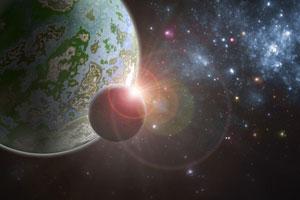Named K2-229b, the planet is 20 per cent larger than Earth but has a mass 2.6 times greater -- and a dayside temperature of over 2000 degrees Celsius


ADVERTISEMENT
Representational picture
London: An international team of astronomers has detected a hot, metallic, Earth-sized planet outside our solar system which has a density similar to Mercury. "Mercury stands out from the other solar system terrestrial planets, showing a very high fraction of iron and implying it formed in a different way," said David Armstrong from University of Warwick in Britain.
"We were surprised to see an exoplanet with the same high density, showing that Mercury-like planets are perhaps not as rare as we thought," Armstrong said.
Named K2-229b, the planet is 20 per cent larger than Earth but has a mass 2.6 times greater -- and a dayside temperature of over 2000 degrees Celsius.
Situated at about 340 million light years away from Earth, it finds itself very close to its host star (around a hundredth of the distance between the Earth and the Sun), which itself is a medium-sized active K dwarf in the Virgo Constellation.
K2-229b orbits this star every fourteen hours, according to the study published in the journal Nature Astronomy.
"Interestingly K2-229b is also the innermost planet in a system of at least three planets, though all three orbit much closer to their star than Mercury. More discoveries like this will help us shed light on the formation of these unusual planets, as well as Mercury itself," Armstrong added.
Using the K2 telescope, Armstrong and colleagues employed the Doppler spectroscopy technique -- also known as the 'wobble method' to discover and characterise this faraway planet.
The dense, metallic nature of K2-229b has numerous potential origins, and one hypothesis is that its atmosphere might have been eroded by intense stellar wind and flares, as the planet is so close to its star.
Another possibility is that K2-229b was formed after a huge impact between two giant astronomical bodies in space billions of years ago -- much like the theory that the Moon was formed after Earth collided with a body the size of Mars, according to the study.
Discovering details about far-flung planets across the universe gives us more clues as to how planets in our own solar system formed.
As K2-229b is similar to Mercury, the researcher believe that knowing more about the former can potentially reveal more about the latter.
Catch up on all the latest Crime, National, International and Hatke news here. Also download the new mid-day Android and iOS apps to get latest updates
This story has been sourced from a third party syndicated feed, agencies. Mid-day accepts no responsibility or liability for its dependability, trustworthiness, reliability and data of the text. Mid-day management/mid-day.com reserves the sole right to alter, delete or remove (without notice) the content in its absolute discretion for any reason whatsoever
 Subscribe today by clicking the link and stay updated with the latest news!" Click here!
Subscribe today by clicking the link and stay updated with the latest news!" Click here!






